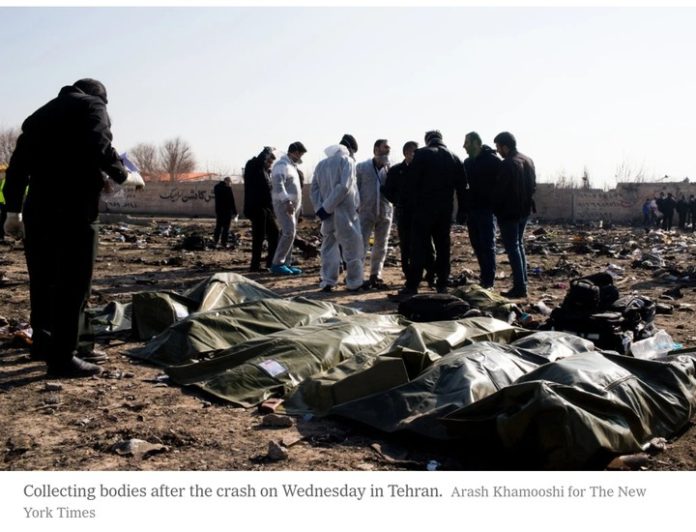Iran’s military announced early Saturday that it had accidentally shot down a Ukrainian passenger jet, blaming human error because of what it called the plane’s sharp, unexpected turn toward a sensitive military base.
After days of tension since the jet crashed near Tehran on Wednesday, the same day that Iranian missiles struck American bases in Iraq, the admission was a stunning reversal. Iran initially maintained that mechanical issues had brought the Boeing airliner down, killing all 176 people aboard.
“The Islamic Republic of Iran deeply regrets this disastrous mistake,” President Hassan Rouhani said on Twitter soon after the military released its statement. He offered condolences to the victims’ families and said investigations were underway. The military said the person responsible would face legal consequences.
International pressure had been building on Iran to take responsibility. American and allied intelligence assessments had already concluded that Iranian missiles brought down the plane, Ukraine International Airlines Flight 752, most likely by accident, amid the heightened tensions between the United States and Iran.
“The little credibility that the Islamic Republic had among its supporters suffered a major blow tonight,” said Rouzbeh MirEmbrahim, an independent Iran analyst in New York and a consultant with the United Nations. “This tragedy undermines the image Iran has cultivated as a military power and weakened it significantly both regionally and internationally.”
On social media, Iranians began expressing anger toward the military soon after the announcement, many of them using the term “harshest revenge,” which officials had repeatedly promised in the wake of the American drone strike that killed Maj. Gen. Qassim Suleimani, a powerful Revolutionary Guards commander, last week.
“They were supposed to take their harsh revenge against America, not the people,” wrote Mojtaba Fathi, a journalist.
The Iranian military’s statement said the plane “took the flying posture and altitude of an enemy target” as it came close to an Islamic Revolutionary Guards Corps base. It said that “under these circumstances, because of human error,” the plane “came under fire.”
The military said it would undertake “major reform in operations of all armed forces” to make sure that such an error never happened again. It said Revolutionary Guards officials had been ordered to appear on state media and give the public a full explanation.
In a statement of his own, Iran’s foreign minister, Mohammad Javad Zarif, tried to place some of the blame on the United States, saying on Twitter that the disaster was “caused by U.S. adventurism.” The military’s statement said there had been information suggesting the United States was “preparing to aerially target sensitive defense and key sites and multiple targets in our country, and this led to even more sensitive defense posture by our antiaircraft units.”
The State Department had no immediate comment late Friday about Iran’s admission of responsibility.
Suspicions that an Iranian missile had brought down the plane were raised immediately after the crash Wednesday morning — just hours after Iran fired missiles at two bases in Iraq housing American forces.
The Iranians asked the National Transportation Safety Board to help with the investigation, and the State Department granted waivers to allow the American agency to help. A senior administration official said Friday that he thought the Iranians wanted American investigators there to keep up the appearance that they did not know what had caused the crash.
The official, who spoke on the condition of anonymity because he was not authorized to discuss these matters publicly, said the Iranian military had poor command and control, and that this was reflected in what had happened with the airplane. Communications among officials and between units are often lacking, he said, and confusion can be the norm. Western analysts often overestimate the capability of parts of the Iranian military, he said.
State television in Iran aired footage that it said showed two flight recorder units recovered from the crash site. Processing their data could take more than a month, and the investigation could take up to two years, Hassan Rezaeifar, the head of the Iranian investigation team, said Friday.
The military announcement came as something of a surprise. As late as Friday night, officials were weighing whether to blame faulty jet equipment in acknowledging that Iranian missiles brought down the jet, according to four Iranians familiar with the deliberations.
Until Saturday, Ukraine’s main intelligence agency, known as the S.B.U., said only that it had narrowed the cause of the crash to a missile strike or a terrorist act and that it could not confirm Western intelligence that an Iranian missile system was likely to blame.
An Iranian report released on Thursday said that the plane, bound for the Ukrainian capital, Kyiv, was in flames before it hit the ground but sent no distress signal.
When Iran began firing missiles early on Wednesday in retaliation for the killing of General Suleimani by the United States in Baghdad, international airlines rerouted flights away from Iran, and the Federal Aviation Administration barred American carriers from the airspace in the region.
After the crash, experts raised questions about why the Iranian authorities had not stopped flights in and out of Tehran.
In Iran, a debate over how much blame the government bears threatened to destroy the national solidarity that followed the country’s conflict with the United States. Many Iranians said that their anger over the lack of accountability at the highest levels of government had quickly returned.
On Friday, Secretary of State Mike Pompeo said that the United States and its allies had intelligence showing that the passenger jet had been shot down. He was the first American official to publicly confirm the intelligence assessments.
Prime Minister Justin Trudeau of Canada, citing a preliminary review of the evidence, called for a full investigation “to be convinced beyond all doubt.” The jetliner was carrying 57 Canadians among its 176 passengers and crew.
“We recognize that this may have been done accidentally,” Mr. Trudeau said at a news conference in Ottawa. “The evidence suggests very clearly a possible and probable cause for the crash.”
President Volodymyr Zelensky of Ukraine made clear on Friday that Western governments had not initially shared the evidence underpinning their assessments that Iran had brought down the Ukrainian jet, though later a spokeswoman said that American officials had handed over more information.
Ukrainian officials also analyzed the plane’s flight pattern on Friday and determined it had stayed within the normal corridor for flights out of Tehran’s Imam Khomeini International Airport, Ukraine’s foreign minister, Vadym Prystaiko, said at a news conference.
“Our goal is to ascertain the undeniable truth,” Mr. Zelensky said in a statement on Friday. “We believe this is the responsibility of the whole international community before the families of the dead and the memory of the victims of the catastrophe.”


